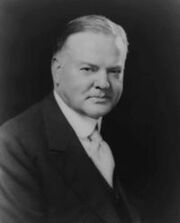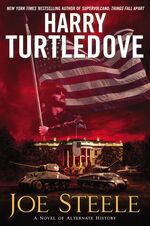| ||||||||||||||||||||||||||||||||||||||||||||||||
Herbert Clark Hoover (August 10, 1874 – October 20, 1964), was an American mining engineer, author, Secretary of Commerce in the 1920s (under Presidents Warren G. Harding and Calvin Coolidge), and the 31st President of the United States (1929–1933). While a popular political figure throughout the 1920s, his responses to the Great Depression as President badly damaged his credibility, and he lost his bid for re-election in 1932 to Franklin D. Roosevelt in a landslide.
Herbert Hoover in Joe Steele
Herbert Hoover was the 31st President of the United States. His failure to end the downward spiral into the Great Depression during his term led to his defeat in the 1932 election at the hands of Democrat Joe Steele.[1] Hoover sought the nomination in 1936, but it went to Alf Landon.[2]
The fundamental difference between Hoover and Steele could be seen in Steele's inauguration on March 4, 1933. President Hoover and his wife, Lou, wore refined (if dated) clothing that suggested their "importance" to the audience. Steele and his wife, Betty, each dressed tastefully, but in clothing the average person might be able to afford.[3]
Herbert Hoover in Southern Victory
Herbert Hoover was the 31st President of the United States from 1933 to 1937, the first Democratic President in 12 years. His was an accidental presidency: he was Calvin Coolidge's running mate in the 1932 presidential election, but Coolidge died of a heart attack before his inauguration, leaving Hoover to assume the office.
Born in Iowa,[4] Hoover was raised in California.[5] Growing up in the period of U.S. history characterized by "Remembrance", Hoover served two years as a conscript before the turn of the century. Hoover had demonstrated an aptitude for science from a young age. During the Great War, Hoover served as a major in the US Army corps of engineers.[6]
Hoover gained national prominence helping to address the Great Mississippi Flood of 1927,[7] and received the Democratic nomination as vice presidential candidate in 1932.[8] Despite the prosperity of the country under Socialist President Upton Sinclair after the Great War, the fortunes of the country had fallen dramatically under Sinclair's successor, Hosea Blackford. The bull-market that had characterized most of the 1920s had finally crashed in 1929.[9] Blackford was unable to deal satisfactorily with the resulting depression. In 1932, the United States found itself in the Pacific War against Japan.[10] While the war was largely a stalemate on the ocean, Japan ran a successful air-raid on the city of Los Angeles on the very day Blackford was in town for a rally in 1932.[11]
Thus, when Hoover was nominated to run with Coolidge, the Democrats were in the strongest position they had been in for over a decade. Coolidge defeated Blackford handily. However, on January 5, 1933, Coolidge died of a heart attack while still president-elect,[12] leaving Hoover to be sworn in as President on February 1.
Despite some of the initial optimism expressed by the voters, Hoover quickly proved a disappointment. His complete contempt for "paternalism" in the federal government rendered him just as ill-equipped to handle the economic depression as Blackford had been. He made this opinion known when Colonel Abner Dowling, military governor of Utah, proposed a make-work plan for the state.[13] Hoover flatly refused, despite the fact that the jobless rate in Utah was further exacerbating that state's already-precarious situation.[14] This stance led the voters to return the Socialists to Congress in 1934.
Hoover's handling of foreign affairs also frustrated many of his supporters in the military. While he continued the policy of rearmament begun by Blackford, the Pacific War ended inconclusively in 1934.[15] After Jake Featherston and the Freedom Party came to power in the Confederate States, Hoover proved indecisive in his dealings with the United States' long-time enemy. When President Featherston pressed for permission to arm more troops to suppress black uprisings,[16] Hoover (after a period of vacillation) acquiesced, justifying his decision by citing his concerns about "radical" elements among the black Confederate community, and naively concluding that Featherston would not use the increased military against the U.S.[17]
While Hoover did stand strong against Featherston on the rebellious states of Kentucky and Houston,[18] which the U.S. had taken from the C.S. following the Great War, it was too little, too late. Growing dissatisfaction with Hoover led him and his running mate William Borah to lose the 1936 Presidential Election to Socialist candidate Al Smith and his running mate Charles W. La Follette.[19]
Hoover served as a pallbearer, alongside fellow former President Upton Sinclair and incumbent Vice President Charles W. La Follette, at Hosea Blackford's funeral in February 1937.[20]
See Also
- References to Historical Figures in Turtledove's Work#Herbert Hoover, for more minor references.
- Al Smith, whom Hoover defeated in the 1928 election in OTL. Smith defeats Hoover in the 1936 election in Southern Victory.
- Franklin D. Roosevelt, who defeated Hoover in the 1932 election in OTL. Roosevelt is also depicted (somewhat counter-intuitively) as Hoover's Secretary of War in the Southern Victory series.
References
- ↑ Joe Steele, pg. 38.
- ↑ Ibid., pg. 134.
- ↑ Ibid., pg. 40-42.
- ↑ The Center Cannot Hold, pg. 382.
- ↑ Ibid., pg. 395.
- ↑ Ibid., pg. 398.
- ↑ Ibid., pg. 399.
- ↑ Ibid., pg. 370.
- ↑ Ibid., pg. 235, et. seq.
- ↑ Ibid., pg. 359, et.seq.
- ↑ Ibid., pg. 377.
- ↑ ibid., pg. 394.
- ↑ Ibid, pg. 496.
- ↑ Ibid., pg. 497.
- ↑ The Victorious Opposition, pgs. 57-58.
- ↑ Ibid., pg. 138.
- ↑ Ibid., pg. 140.
- ↑ Ibid., pg. 205.
- ↑ Ibid., pgs. 215-217.
- ↑ Ibid., pg. 290
| Titles and Succession | ||||||||||||||||||||||||||||||||||||||||||
|---|---|---|---|---|---|---|---|---|---|---|---|---|---|---|---|---|---|---|---|---|---|---|---|---|---|---|---|---|---|---|---|---|---|---|---|---|---|---|---|---|---|---|
| ||||||||||||||||||||||||||||||||||||||||||
| |||||||||||||||||||||||||||||||||||||||||||||||||||||||||||||||||||||||||||||||||||||||













